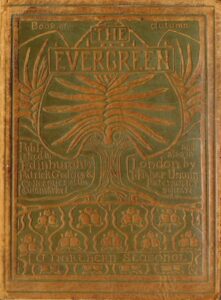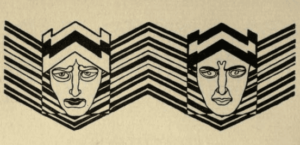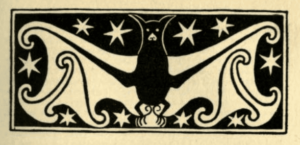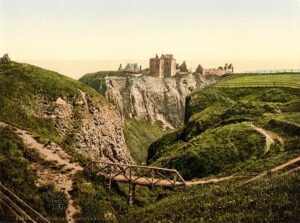The Scottish Renaissance in Sir George Douglas’ “Cobweb Hall” and Margaret Thomson’s “The Story of Castaille Dubh”
©Faye Hamidavi, Ryerson University 2018
Introduction

The Evergreen: A Northern Seasonal is a four-part serial published by Patrick Geddes and William Sharp seasonally between 1895 and 1897. One volume exists for each season, with each individual volume’s contents curated in keeping with the season (Kooistra, “General Introduction”). Sir George Douglas’ “Cobweb Hall” is situated in the Autumn volume of The Evergreen, whereas The Winter volume features Margaret Thomson’s “The Story of Castaille Dubh”. While both stories include death as a central topic, the way it is treated in both texts is quite different. Despite their differences, both “Cobweb Hall” and “The Story of Castaille Dubh” portray the theme of death in keeping with their individual volume’s themes. Through the portrayal of death, both works participate in the Scottish Renaissance, contributing to the magazine’s cultural revolution.
Scotland in the 1890s
Nineteenth century Scotland is often overlooked in history. Historians consider the period to be a time of “cultural sub-nationalism,” due to the Act of Union in 1707 and the effect it had on Scottish culture (Morris and Morton 90). After the Act of Union, Scotland struggled with its identity because the nation had to share the state with Britain (Morris and Morton 90). Industrialization and urbanism began to rise, and Scotland reached new levels as a bureaucratic state during the nineteenth century (Morris and Morton 92, 95). This newfound independence is part of what incited the rebirth of Scottish culture.
The Scottish Renaissance fought to reclaim much of the cultural identity that had been lost in the country’s tensions with Britain. History was introduced into Scottish arts curriculums in 1894. Professors taught origin myths and narratives that merged past stories with present society, legitimized Scotland as a national state, and celebrated historical and fictional heroes (Anderson 2-3). Introducing Scotland’s history to students is a reclamation of Scottish heritage that had previously been lost. The passing on of traditional folklore served as a reawakening of Scottish culture and literature. By bringing these stories back to life, teachers and students alike participated in the renewal of traditional Scottish art, and culture (Dunnigan 41). This renewal is inherent in the Scottish Renaissance.
The Evergreen and The Scottish Renaissance
The Evergreen’s primary focus was uniting the arts and science in order to express their message of social regeneration and cultural revolution. Contents of the magazine include both folklore and Celtic fairy-tales in the form of art, poetry, and fiction, along with scientific essays (Kooistra, “General Introduction to The Evergreen”). It was released semi-annually, with each of its four volumes focussing on a specific season and the themes associated with it.
Unlike the renaissance period of other nations, Scotland’s renaissance period takes place primarily in the early twentieth century (Jack 66). While The Evergreen’s print run ended just before the turn of the century, the magazine’s contributions to the cause are long-lasting. Other magazines of the same period were focussed heavily on aesthetics and literary art, but The Evergreen considered itself “the beginning of an effort to give periodic expression in print to a movement that is mainly architectural, educational, scientific” (Branford). The creators of the magazine were looking to do much more than just tell stories; they wanted to incite a cultural reawakening within Scotland.


Situating “Cobweb Hall” and “The Story of Castaille Dubh”
Sir George Douglas’ “Cobweb Hall” tells the story of an old abandoned house in the outskirts of Berwickshire, detailing the account of a butler who murders his Mistress and is hanged for his crimes after being found hiding in a neighbouring field. “Cobweb Hall” was written by Sir George Douglas, a baronet who combined running his elaborate estate with his career as a writer and historian (“Sir George Brisbane Douglas, D1935”). His work was widely renowned in Scotland, and after his death, Halbert J. Boyd claimed: “Scotland has suffered the death of one of her most distinguished sons” (4). His work appears in The Evergreen two more times, with “Song” in volume 3, and “A Winter Song” in volume 4. However, “Cobweb Hall” is Douglas’s only work in the magazine that is not a poem.
“The Story of Castaille Dubh” is a folk tale about the cursed castle titled Castaille Dubh, also known as The Black Castle. During the Scottish civil war, the castle is taken over by a tyrant who enslaves the town. When a sickness overtakes the castle, the townspeople refuse to aid the new Earl and captor, often stealing their food and raping their women. Despite the fact that the sickness would kill the Earl and his family regardless, three men set the castle on fire one night in an act of revenge. Little scholarship exists regarding Margaret Thomson, the author of “The Story of Castaille Dubh”, and this story is her only work featured in The Evergreen.
Ties to Scottish Nationalism in “The Story of Castaille Dubh”

“The Story of Castaille Dubh”‘s ties to Scottish Nationalism are quite apparent throughout the text. The three protagonists represent the Scottish Renaissance in metaphorical form. The ruler who enslaves the town serves as the loss of Scottish culture, and when the three men slay the ruler and burn down Castaille Dubh, they are metaphorically reclaiming their heritage from this outsider. The protagonists get painted as heroic figures due to their bravery throughout their journey. In the first description of the castle, it is said to contain vast treasure; however, “not the boldest nor the most covetous among them has dared to seek for it” (Thomson 128). This sets the castle up as a dangerous place that few men would dare to tread. In addition to this, when the men begin their journey, they are faced with various obstacles such as the “dread white water-bull” that the castle emitted as well as the “thin ice [that] crackled under their feet” (Thomson 131). This description shows their immense bravery in their struggle, setting them up as heroic figures.
Another important way the story ties into nationalism is through the way the text fosters identification with its intended audience. As we have already understood, The Evergreen concerned itself primarily with the Scottish Renaissance. This renaissance requires a rejection of Scotland’s potential assimilation with England (Harvie 28). In order to amplify this idea in the text, Thomson describes the intruders from the South as tyrannical monsters that take advantage of the townspeople, whereas the townspeople are shown as hardworking community members who just want to take care of their families. The “bolder” of these townspeople exclaim: “‘what are these Southerners to us? They are no kith nor kin of ours’” (Thomson 130). This line encourages an us versus them mentality amongst readers which promotes the idea of rejecting assimilation promoted by Scottish Renaissance enthusiasts of the time period.
Ties to Scottish Nationalism in “Cobweb Hall”
“Cobweb Hall” is a much subtler component of The Evergreen’s participation in the Scottish Renaissance when compared to “The Story of Castaille Dubh.” Nevertheless, it highlights many of the same ideals prevalent in Douglas’s story, and follows the literary renaissance style dictated by Yeats. Douglas’ story is a retelling of an old Berwickshire legend, situating it as a Celtic folktale (Kooistra, “Critical Introduction to The Evergreen Volume 2”). In an essay published regarding the traditional characteristics of Celtic literature, Yeats cites and “imaginativeness,” “passion for nature,” and “melancholy” as notable components of Celtic folklore (270-295). All of these components play a key role in Douglas’s retelling of “Cobweb Hall.” The plot structure highlights the imaginativeness because the protagonist of the story is actually the murderer. One would typically expect a tale to be told from the hero’s perspective, not the villains, so by switching the narrative around to focus on the butler’s account of the events, the imaginativeness of Scottish folklore is highlighted in the tale.
“Cobweb Hall” also features a passion for nature in keeping with Yeats’ characteristics of Celtic literature. The story starts with a full page of descriptive text regarding the building and its surroundings. Douglas paints a picture of the “dark neglected shrubbery, originally laid out with box-edged walks and planted with laurels and with tufts of the old-fashioned butcher’s broom” that was once beautiful but is now “defaced” because it is no longer being tended to (Douglas 43). Descriptions such as this are used to describe the entire house, setting the scene for the story that occurs within the building’s walls. The decadent description of the scenery showcases the Celtic passion for nature as it comes across in Douglas’ story.
Melancholy is an integral component of “Cobweb Hall” as well. In the letter he pens following his capture, the butler states he has “already suffered the pain of more than twenty deaths”, and claims that “the law has nothing to gain in depriving [him] of [his] miserable life” (Douglas 55). This quote shows how depressed the butler is feeling after murdering his mistress. By including this passage, suggesting that the butler is suffering more being alive than he would dead, the melancholy elements of Celtic literature are clearly brought forth in the tale.
Autumn vs. Winter in The Evergreen
An interesting component to consider when analyzing these stories is what volumes they fall into. “Cobweb Hall” is situated in the autumn volume of The Evergreen, whereas “The Story of Castaille Dubh” belongs to the winter volume. The autumn volume of The Evergreen deals with the theme of individual death (Kooistra, “Critical Introduction to The Evergreen Volume 2”). “Cobweb Hall” fits perfectly into this theme because the story focusses on the individual death of Miss. Clinkscales and the man who murders her. This tale is specific in its telling, providing a detail-oriented story about her murder. The folk-tale fits into the theme of individual death well, situating the story comfortably among the other pieces in the autumn volume of The Evergreen.
The winter volume is thematically involved with death as well. However, unlike the autumn volume, the fourth instalment of The Evergreen focusses on the hope and remembrance of the unseen, looking ahead to a brighter season and future (Kooistra, “Critical Introduction to The Evergreen Volume 4”). The importance of hope and rebirth in the winter volume makes it clear why “The Story of Castaille Dubh” is situated within this publication. The town is distraught over the tyrannical ruler who has enslaved them. With his death at the end of the tale, it can be inferred that the town will reclaim its freedom. This heroic end and birth of a newly independent township situates the tale in The Evergreen’s winter publication.
Understanding the themes accompanied by each volume makes it clear why both stories were situated in their particular volumes. It also makes it clear why both stories handle death in contrasting ways. The heroism of the three men’s revenge in “The Story of Castaille Dubh” represents the hope and rebirth of winter. In contrast, the darkness of murder in “Cobweb Hall” highlights the tribulations of individual death in keeping with autumn.
Conclusion
Before delving into my research, it seemed to me that “Cobweb Hall” was completely unlike “The Story of Castaille Dubh” in its relation to the Scottish Renaissance. However, it turns out that both do a fine job emulating many of the themes pertaining to the literary period and its cultural importance. As little scholarship pertaining to Douglas and Thomson’s respective works exists, this research is important in understanding the role both authors played in The Evergreen’s participation in the Scottish Renaissance.
Works Cited
Anderson, Robert. “University History Teaching, National Identity and Unionism in Scotland 1862-1914.” The Scottish Historical Review, vol. 91, no. 231, 2012, pp. 1–41. JSTOR, www.jstor.org/stable/43773885.
Boyd, Halbert J. “An Appreciation.” Southern Reporter, 27 June 1935, p. 4. British Newspaper Archive, www.britishnewspaperarchive.co.uk/viewer/BL/0000469/19350627/060/0004?browse=true.
Branford, Victor V. “Old Edinburgh and The Evergreen.” Rev. of The Evergreen vol. 2, Autumn 1895, The Bookman, vol. 9, no. 51, December 1895, pp. 88-90. Yellow Nineties 2.0, edited by Lorraine Janzen Kooistra, Ryerson University Centre for Digital Humanities, 2018. 1890s.ca/HTML.aspx?s=EG2_Review_Bookman_1895.html.
Douglas, Sir George. “Cobweb Hall.” The Evergreen: A Northern Seasonal, vol. 2, Autumn 1895, pp. 43-55. The Yellow Nineties Online, edited by Lorraine Janzen Kooistra, Ryerson University Centre for Digital Humanities, 2018. https://1890s.ca/egv2_douglas_cobweb/.
Harvie, Christopher. “The Nationalism of the Literati.” Scotland and Nationalism: Scottish Society and Politics 1707 to the Present, Routledge, 2004. Google Books, books.google.ca/booksid=tX9_AgAAQBAJ&lpg=PP1&dq=scottish%20nationalism&pg=PA27#v=onepage&q&f=false.
Jack, R. D. S. “‘Translating’ the Lost Scottish Renaissance.” Translation and Literature, vol. 6, no. 1, 1997, pp. 66–80. JSTOR, www.jstor.org/stable/40339760.
Kooistra, Lorraine Janzen. “Critical Introduction to The Evergreen: A Northern Seasonal Volume 2: Autumn 1895.” Evergreen Digital Edition, Yellow Nineties 2.0, edited by Lorraine Janzen Kooistra, Ryerson University Centre for Digital Humanities, 2018. www.1890s.ca/egv2_introduction/.
Kooistra, Lorraine Janzen. “Critical Introduction to The Evergreen: A Northern Seasonal Volume 4: Winter 1896/7.” Evergreen Digital Edition, Yellow Nineties 2.0, edited by Lorraine Janzen Kooistra, Ryerson University Centre for Digital Humanities, 2018. https://1890s.ca/egv4_introduction/.
Kooistra, Lorraine Janzen. “General Introduction to The Evergreen: A Northern Seasonal (1895-97),” The Yellow Nineties Online, edited by Lorraine Janzen Kooistra, Ryerson University Centre for Digital Humanities, 2018. https://1890s.ca/the-evergreen-general-introduction/.
Morris, R. J., and Graeme Morton. “Where Was Nineteenth-Century Scotland?” The Scottish Historical Review, vol. 73, no. 195, 1994, pp. 89–99. JSTOR, www.jstor.org/stable/25530618.
“Sir George Brisbane Douglas, D1935.” The Douglas Archives, www.douglashistory.co.uk/history/georgebrisbanedouglas.htm. Accessed 18 Nov. 2018.
Thomson, Margaret. “The Story of Castaille Dubh.” The Evergreen; A Northern Seasonal, vol. 4 Winter 1896-7, pp. 128-131. The Yellow Nineties Online, edited by Lorraine Janzen Kooistra, Ryerson University Centre for Digital Humanities, 2018. https://1890s.ca/egv4_thomson_castailledubh/.
Yeats, William Butler. “The Celtic Element in Literature.” Nineteenth-Century Literature Criticism, edited by Joann Cerrito, vol. 44, Gale, 1994. Literature Resource Center, link.galegroup.com/apps/doc/H1420021297/LitRC?u=rpu_main&sid=LitRC&xid=bb 18b914. Originally published in Ideas of Good and Evil, by William Butler Yeats, A.H. Bullen, 1903, pp. 270-295.
Images in this online exhibit are either in the public domain or being used under fair dealing for the purpose of research and are provided solely for the purpose of research, private study, or education.
